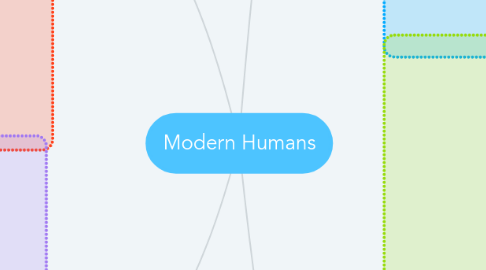
1. Biological Anthropology
1.1. Forensic
1.1.1. Requires detailed knowledge of osteology
1.1.2. Process: search, contextualization, excavation, recovery
1.1.3. Application of biological anthropology in medicolegal context
1.1.4. Interpretation of context of remains
1.2. Biological Profile
1.2.1. Sex
1.2.2. Age
1.2.3. Inventory
1.2.4. Stature
1.3. Trauma
1.3.1. Ballistic
1.3.1.1. Weapons
1.3.1.2. Fracture types reveal the issue
1.3.2. Timing
1.3.2.1. If before death there are usually signs of healing
1.4. At Work
1.4.1. Mass disaster
1.4.2. Justice
1.4.3. Military recoveries
1.4.4. Law enforcement consultations
2. World Development and Ethics
2.1. World System
2.1.1. Euro exploration linked old and new world
2.1.2. Sugar was a key factor
2.1.3. Slave trade
2.2. Colonialism
2.2.1. "White man's burden", racist narrative that white people had to govern over others
2.2.2. British colonial empire
2.3. Climate Change
2.3.1. Greenhouse effect
2.3.2. Temperature rise
2.3.3. Fossil fuels
2.4. Ethics and Remains
2.4.1. Otologists deal with how to use human remains ethically
2.4.2. Different based on location
2.5. Anthropology allows us to see how the world actually works
2.6. Intelligence Tests
2.6.1. Intelligence Quota (IQ)
2.6.2. Stanford-Binet Tests
2.6.3. Used to justify racist superiority laws
3. Rise and Expansion
3.1. Early AMH Africa
3.1.1. Earliest in Ethiopia about 195,000 years ago
3.1.2. Mix of modern and archaic features
3.1.3. Chin appears about 90,000 years ago
3.1.4. Complex stone tools
3.2. Early AMH Asia
3.2.1. Appeared about 90,000 years ago
3.2.2. Not a lot of data on tools but similar style to Africa
3.2.3. Mix of modern and archaic features
3.3. Early AMH Europe
3.3.1. Appeared about 30,000 years ago
3.3.2. Distinct modern features
3.4. Origin/Despersal
3.4.1. From Africa model
3.4.2. Multiregional continuity model
3.4.3. Assimilation model
3.5. Culture
3.5.1. Aurignacian
3.5.1.1. Earliest blades
3.5.1.2. Beads and jewelry
3.5.1.3. Bone needles
3.5.1.4. Cave Art
3.5.1.4.1. 35,000 years ago
3.5.1.4.2. Lots of depictions of animals
3.5.2. Gravettian
3.5.2.1. Carved figurines
3.5.2.2. More complex blades
3.5.2.3. Burials decorated with jewelry
3.5.3. Solutrean
3.5.3.1. Very fine stone technology
3.5.3.2. Domestication of the dog
3.5.3.3. Venus figurines
3.5.4. Magdalenian
3.5.4.1. Barbed harpoons, fishing
3.5.4.2. Very detailed cave art
3.5.4.3. Increased sedentism
3.6. Migrations
3.6.1. Reasons
3.6.1.1. Population increase
3.6.1.2. Loss of food sources
3.6.1.3. Increased competition
3.6.1.4. Climate change
3.6.2. Mass movements occurred throughout history for various reason, aided by sea level changes, land bridges etc.
4. Osteology and Bioarcheology
4.1. Skeleton
4.1.1. Bones preserve human tissue
4.1.2. Conservative over time
4.1.3. Plasticity, can change over the course of a life
4.2. Variation
4.2.1. Idiosyncratic
4.2.2. Sexual
4.2.3. Age
4.3. Musculoskeletal System
4.3.1. Origin, stable during movement, attachment site on bone
4.3.2. Insertion, attachment site on bone that moves
4.3.3. Tendons, tissue that connects muscle to bone
4.4. Growth
4.4.1. Nutrition
4.4.2. Hormones
4.4.3. Sex steroids at puberty
4.5. Teeth
4.5.1. Can tell type of food eaten
4.5.2. Can tell size of the person
4.5.3. Often show sexual dimorphism
4.5.4. Preserve well
4.5.5. Can tell about behavior
4.6. Issues
4.6.1. Degenerative joint disease
4.6.2. Tuberculosis
4.6.3. Trauma
4.7. Bioarcheology
4.7.1. Study of human remains from an archeological standpoint
4.7.2. Gives a record of the past
4.7.3. Reconstructs identity
4.7.4. Biological profile
4.7.5. Age estimation
4.7.6. Tells sex
4.7.7. Shows stress and trauma
4.8. Agriculture and Domestication
4.8.1. Population growth led to plant domestication needs
4.8.2. Reduced biodiversity
4.8.3. Physical activity causes degradation of body
4.8.4. Health costs
4.8.4.1. Diseases
4.8.4.2. Oral health issues, caries
4.8.4.3. Nutritional stress
